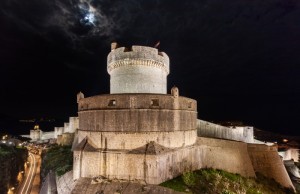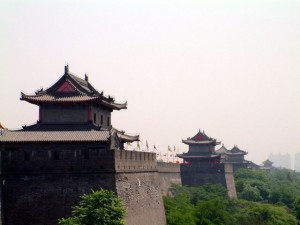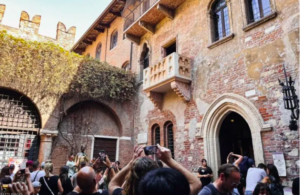The town of Mystra in the Peloponnese was among CNN’s online travel edition 10 best medieval walled cities in the world. Reporter Bruce Holmes, who has visited quite a few presents his top 10 list:
For history buffs, photographers and anyone who’s ever said “Wow!” there’s nothing quite like the sight of a medieval walled city approached from a distance.
Then there are the explorations within, tours of castles, walks along the walls and shops and restaurants in medieval squares. Many cities still have their medieval walls predominantly intact in various parts of the world. Did I mention my obsession? I’ve visited quite a few.1. Pingyao, China
Situated in Shanxi province, the 14th century Han Chinese city of Pingyao was once China’s foremost financial center with half the country’s banks located there.
Today it retains its layout from the Ming and Qing dynasties and this, together with its impressive city walls, saw it World Heritage listed in 1997.
Construction of the city walls began under the Emperor Hongwu in 1370. They stand 12 meters high, have a six-kilometer perimeter, six gates, 72 watchtowers and a moat outside.
Today, the shops and markets in the medieval streets are also worth a visit.
2. Carcassonne, France
After the Treaty of the Pyrenees in 1659 Carcassonne no longer guarded the frontier and its beautiful stonework and towers deteriorated till merchants cried, “Pull it down.”
Thankfully an awareness of heritage saw it classified as a protected monument in 1849 and architect Eugene Viollet-le-Duc was commissioned to restore it. His work was one reason for the site’s World Heritage listing.
Visitors can tour the Chateau Comtal within the walled city, examine the Basilica of Saint-Nazaire and Saint-Celse, or — when it’s time for a breather — I recommend a meal with local-area wine at La Bonne Demeure on the medieval square.
Driving away, we stop to look back. Instead of roofless, ruined towers the slate roofs glint in the sun atop a 13th-century fortress city that dominates the horizon. We stand in awe.
3. York, England
The historic Northern English city of York has plenty of history — and plenty of ghosts. Find out more on The Original Ghost Walk of York, which calls itself the first exclusive ghost walk in the world. York has a significant proportion of its walls intact, more than any other city in England. The visitor can walk along them, stopping at small museums at some of the gates. Beneath the medieval city walls lies remains of earlier Roman brickwork.4. Dubrovnik, Croatia
Most of the existing walls and fortifications surrounding the old center of the Adriatic port city of Dubrovnik were constructed during the 14th and 15th centuries, but parts were extended and strengthened even up to the 17th century.
No hostile army ever breached them during the Middle Ages and while the earthquake of 1667 destroyed many buildings, it left the walls largely unscathed.
Walk the two-kilometer circuit of the walls for fantastic views of the sea. You can also admire the old city that lies within the walls. Take water and wear a hat and sunscreen — there’s precious little shade.
5. Xi’an, China
Looking out from the fortified wall in Xi’an, there’s a striking contrast. In the foreground stands a watchtower, cannon and red Chinese lantern; in the distance a modern apartment building looms.
The earlier wall was rebuilt in 1378 by Ming Emperor Zhu Yuanzhang. It’s one of the best preserved fortified city walls in the world, standing 12 meters high, 12-18 meters thick and 14 kilometers long.
Walking along the top is a good way to gain a city perspective, though tourists will more often be seen on bicycles — there’s plenty of room here, the breadth of the wall having been designed to facilitate troop movements.
6. Obidos, Portugal
Ringed by medieval walls, the hill-top town of Obidos with its Moorish castle was recaptured by the first king of Portugal, D. Afonso Henriques, in 1148 and from then until 1883 it became the property of the Queens of Portugal.
Visitors who truly want to relive the medieval should visit in July for the Mercado Medieval — for two weeks the castle hosts a medieval market complete with heraldic flags, jugglers, minstrels and spit-roast feasting.
You can even drink from a pewter tankard to get into the spirit of things.
7. Quebec City, Canada
Walking along the ramparts of the city’s 4.6 kilometers of walls and through the gates in old Quebec is an historic experience, this being one of the few cities in North America to have preserved its fortified line of defense.
We’re lucky this World Heritage feature survived at all, for in the 19th century people tore down gates and parts of the wall. But a new Governor-General, Lord Dufferin, turned public opinion and saved the fortifications for posterity.
The “new” St Louis Gate, re-built in 1878, is a testament to his efforts and provides a sense of old world charm — horse and carriage often pass through it on a beautiful clear morning.
8. Taroudant, Morocco
From 1509 Taroudant was the capital city of the Saadi dynasty of Morocco, until they moved on to Marrakech. Mohammed ash-Sheikh constructed the city walls and built the great mosque and its minaret in 1528.
The red earth walls encircle virtually the whole town and are six kilometers long, with bastions and gates.
Situated in the Sous valley in the south of the country, Taroudant’s Arab souk sells a variety of crafts including pottery, copper work, carpets and jewelry.
9. Mystras, Greece
Not every walled city is still inhabited. On Mount Taygetos near Sparta in the Peloponnese lies the archaeological treasure that is the abandoned city of Mystras, where the last Byzantine emperor, Constantine XI Palaiologos, was crowned in 1449.
Mystras was founded in 1249 by a Frankish crusader, William II of Villehardouin, but it soon came under Byzantine control and later fell to the Turks in 1460. Eventually, the inhabitants of Mystras gave up and moved away.
Among several religous sites at Mystras, the church of Our Lady Peribleptos is decorated with rare frescoes which are perfect examples of Byzantine art dating from the 14th century.
10. Avila, Spain
When ruled by Arabs, the city of Avila suffered repeated attacks by Iberian Christian kingdoms until it lay abandoned. It was repopulated under the rule of the Christian Raymond of Burgundy in the 11th century and he began building the defensive walls.
With 88 semi-circular towers punctuating its 2.5-kilometer perimeter, the wall makes for an impressive sight. One of its six gates leads straight up to the Gothic cathedral which is a virtual fortress fixed to the wall.
The city was the birthplace of Saint Teresa of Avila, a prominent Carmelite nun and mystic. Also prior to the 18th century there were more than 100 mansions in the city, which is why its full name is Avila de los Caballeros, or Avila of the Noblemen.
source: CNN
Ask me anything
Explore related questions














